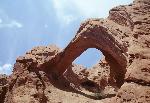Joseph Grimaldi (London, England, 1778; died London, England, May 31, 1837) was known as Joey the Clown. His antics added much to theater humor. Children could become clowns today and wear clown makeup. They could organize into small groups and create clown skits.
Judith Heumann (born Brooklyn, New York, 1947; died Washington, DC, March 4, 2023) was called the “Mother of the Disability Rights Movement.” She contracted polio when she was eighteen months old and used a wheelchair the rest of her life. She organized the 504 Sit In that ultimately produced the 1990 Americans with Disabilities Act. Children could read Fighting for Yes! The Story of Disability Rights Activist Judith Heumann, written by Maryann Cocca-Leffler and illustrated by Vivien Mildenberger.
Paul Klee (born near Bern, Switzerland, 1879; died Muralto, Switzerland, June 29, 1940) was an artist. His paintings exude a dreamlike, fantasy quality. Children could visit a website at: Paul Klee.
Marilyn Sachs (born Bronx, New York, 1927; died San Francisco, California, December 28, 2016) wrote 35 children’s books. Her books include Lost in America and A Pocket Full of Seeds.
Steven Spielberg (born Cincinnati, Ohio, 1946) is a film producer and director. Among his credits are Jurassic Park and Close Encounters of the Third Kind. Idea: Spielberg’s movies are very popular. Children could visit: Spielberg. Scholars could investigate the revenues from the movies and make a bar graph to indicate the results.



 d in 1971. Located in southern Utah, the park follows a one hundred-mile wrinkle in the earth’s crust. Visitors can view fossils, petrified trees, and Native American ruins. Children can visit the park’s website, featuring great panoramas and wonderful photos, at:
d in 1971. Located in southern Utah, the park follows a one hundred-mile wrinkle in the earth’s crust. Visitors can view fossils, petrified trees, and Native American ruins. Children can visit the park’s website, featuring great panoramas and wonderful photos, at: 

